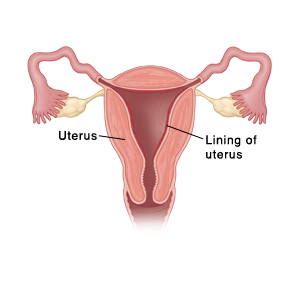Amenorrhea
 |
| Normally, the uterine lining builds up and is shed each month during a woman’s period. With amenorrhea, this process does not happen. |
Menstruation occurs when a woman sheds the lining of her uterus. It's also called a period. For most women, this happens once a month. But some women may not get their periods. This is called amenorrhea.
Amenorrhea may be due to a number of causes. These include:
-
Pregnancy, breastfeeding, or menopause.
-
Hormone problems.
-
Emotional stress.
-
Very low body weight.
-
Exercising too much.
-
Poor nutrition or eating disorders.
-
Taking certain medicines.
-
Having certain birth defects or genetic disorders.
There are 2 types of amenorrhea:
One or more tests can be done to find out why you’re not having periods. These include blood tests and imaging tests. Once the cause is found, it may be treated. Treatments can range from lifestyle and diet changes to medicines, procedures, or surgery. Your doctor will discuss choices with you as needed.
Follow-up care
Follow up with your doctor as advised. You'll be told the results of any tests as soon as they are ready.
Pregnancy
Note: Know that you can still become pregnant even if you are not having regular periods. It's important to use some form of birth control if you are sexually active and don't want to get pregnant.
When to get medical advice
Contact your doctor right away if you have:
-
Severe pain in the belly (abdomen).
-
Belly swelling.
-
Sudden, severe vaginal bleeding.
-
Feeling faint or passing out.
Online Medical Reviewer:
Heather M Trevino BSN RNC
Online Medical Reviewer:
Tennille Dozier RN BSN RDMS
Date Last Reviewed:
7/1/2025
© 2000-2025 The StayWell Company, LLC. All rights reserved. This information is not intended as a substitute for professional medical care. Always follow your healthcare professional's instructions.